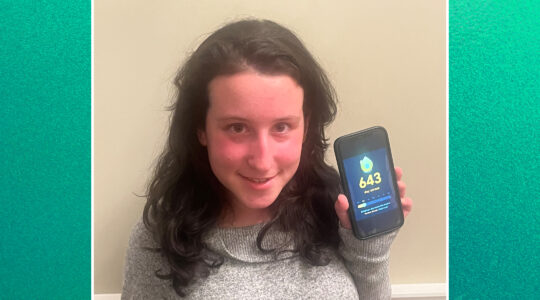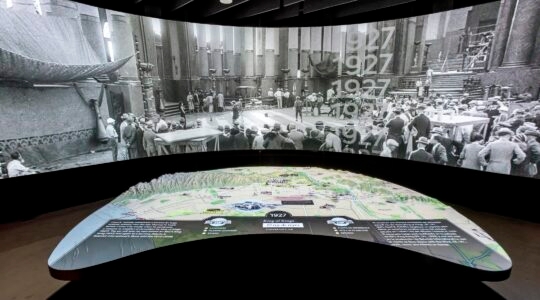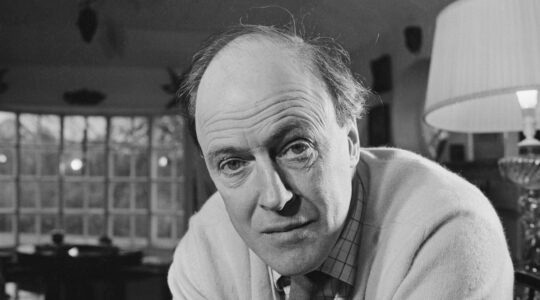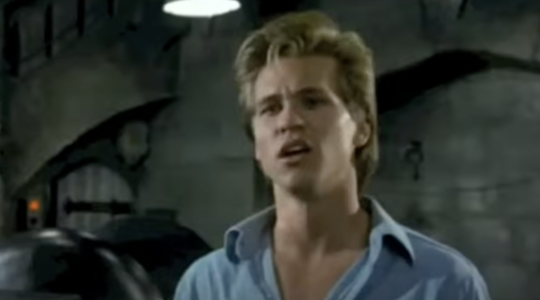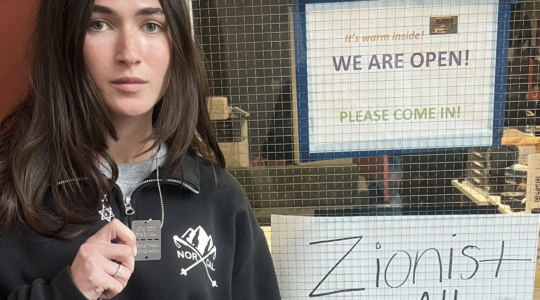NEW YORK (JTA) — May is Jewish American Heritage Month, a commemoration first recognized by President George W. Bush in 2006. Since then, hundreds of programs have taken place nationwide annually to honor the rich contributions of Jews to American culture and society.
President Obama added to the annual festivities by launching an annual White House bash. But this year’s party was canceled because of the sequester.
Not to worry: In anticipation of the big month, we’re suggesting 31 activities to keep you busy each day in May. You’ll see some usual suspects, but will also find new ideas in entertainment, food and travel, and overall fun. We’re pretty sure you’ll find something of interest.
If we’ve somehow missed the mark, feel free to participate in the epitome of American Jewish hobbies: kvetching.
For a rundown of official Jewish American Heritage Month events, visit www.jahm.us. You can also follow @USAJewish on Twitter.
1. Make cholent
Our people are into stews. So is it really surprising that the great American Crock-Pot originally was coined the Naxon Beanery All-Purpose Cooker after its Jewish inventor, Irving Naxon? Naxon, who died in 1989 with more than 200 patents in his name, conceived an inexpensive and safe heating element inspired by his mother’s tales of making the traditional Sabbath meat-and-potato stew — a nearly 24-hour process — in her Lithuanian shtetl (his daughter recently wrote about her family memories for the Beyond Bubbie online food project). Not into the idea of cholent? Toss anything into a Crock-Pot, from lentils to grits to an entire chicken, and thank Mr. Naxon for making cooking so darn easy.
2. Celebrate Hollywood’s female showrunners

Lena Dunham, shown speaking in October 2012 at the Fortune Most Powerful Women Summit in Washington. (Krista Kennell/ Fortune Most Powerful Women Summit)
In case you hadn’t heard, Jewish American women are taking the entertainment world by the beitsim. Writer-director-producer Jill Soloway won the 2013 Sundance Award for U.S. Dramatic Directing for her debut film, “Afternoon Delight” (she also founded the Los Angeles community organization East Side Jews). Allison Silverman, the former co-executive producer of the“Colbert Report,” has been penning episodes for “The Office” and “Portlandia,” the IFC show starring hipster Jew Carrie Brownstein. And creator-star-writer-director Lena Dunham, she of the million-dollar book proposal, has turned the HBO series “Girls” into a cultural sensation along with showrunner Jenni Konner. Buy a movie ticket, subscribe to HBO or tune in to NBC, and thank the ladies for the laughs.
3. Start a book club
Put down the Angry Birds and dive into a tale written by a young American Jewish author. Some ideas to start out the list: “What We Talk About When We Talk About Anne Frank,” Nathan Englander’s elegant and darkly humorous collection of short stories; “Jujitsu Rabbi and the Godless Blonde,” Rebecca Dana’s debut memoir about living with a lapsed hasidic rabbi in Crown Heights while nursing a broken heart; and “Tomorrow There Will Be Apricots,” Jessica Soffer’s (no relation) debut novel inspired by her love of cooking and her Iraqi Jewish heritage. All are available on Amazon, Kindle and Audible.com.
4. Take a Philip Roth bus tour
Novelist Philip Roth, a Pulitzer Prize and National Book Award winner, turned 80 in March, and his hometown of Newark, N.J., has rolled out the red carpet for celebrations. For a man referred to as the greatest living American writer, the Newark Preservation and Landmarks Committee is running a bus tour showcasing highlights from his novels and early life in the city. It’s not too late to check out “Philip Roth: An Exhibit of Photos From a Lifetime,” a show of some 100 photographs running through Aug. 31 at the Newark Public Library. Can’t get to North Jersey? Check out the next PBS “American Masters” airing of “Philip Roth: Unmasked,” a documentary featuring the author discussing intimate aspects of his life, or just reread “Portnoy’s Compaint” and call your mother already. For all things Roth, visit rothsociety.org.
5. Go shopping
From Marc Jacobs to Zac Posen to Rachel Zoe and beyond, American Jews are some of the biggest players in the fashion design industry. In honor of Jewish American Heritage Month, treat yourself to some retail therapy at Bloomingdale’s, Loehmann’s (the legendary discount haven started by Frieda Loehmann, an American Jewish woman, in 1921) or any store near you. And after you schlep your overstuffed bags home, watch “Schmatta: From Rags to Riches to Rags”, the 2009 documentary about the once vibrant but now fading Garment District in Midtown Manhattan, and marvel that the population of Jewish fashion talent and workers was so dense that the area warranted its own place of worship, the Millinery Center Synagogue.
6. Write a poem
American Jews have produced a rich variety of poetry, including Allen Ginsberg’s “Howl,” Robert Pinsky’s tributes to baseball, and Adrienne Rich’s feminist and lesbian fury. A notable example is Emma Lazarus, a New York Jew and early Zionist of Sephardic descent who wrote the sonnet “The New Colossus” in 1883 at age 34, shortly after witnessing the Russian pogroms. If you don’t recognize the title, how about the lines: “Give me your tired, your poor, Your huddled masses yearning to breathe free.” They appeared on a bronze plaque in the pedestal of the Statue of Liberty in 1903, 16 years after her death. Compose your own poem on Smith Mag’s online Six Words on Jewish Life page. You can also read a compilation of its best submissions, including Nora Ephron’s words of wisdom: “Secret to life: marry an Italian.”
7. Rock out

San Francisco-based punk duo Happy Fangs with singer Rebecca Bortman, a Pittsburgh Jew. (Happy Fangs Facebook)
American Jews have long embraced pop, rock and hip-hop. We all know about the Beastie Boys, Van Halen and the Bangles (Susanna Hoffs is a nice Jewish girl from L.A.). Discover some newer bands this month, such as the San Francisco-based punk duo Happy Fangs featuring singer Rebecca Bortman, a Pittsburgh Jew; New York City’s The Sway Machinery, whose amalgamated style is rooted in band leader Jeremiah Lockwood’s early experience singing in the choir of his grandfather, Cantor Jacob Konigsber; and L.A.’s indie-folk pop duo The Wellspring, whose members Talia Osteen and Dov Rosenblatt had an official showcase at this year’s SXSW festival and who are scoring tracks for the upcoming feature film “Coffee Town.”
8. Make springtime pickles
At least that’s what Jeffrey Yoskowitz will be doing. He helps run The Gefilteria, a Brooklyn-based purveyor that re-creates Old World Jewish foods such as gluten-free gefilte fish made with sustainably sourced fish, kvas (a naturally fermented beet tonic) and carrot-citrus horseradish. Try it with cukes by using lacto-fermentation, a process that preserves vegetables simply with salt, water and spices. Alternate plan: Order some Gefilteria products online and enjoy while watching “Crossing Delancey,” which was released 25 years ago.
9. Listen to “Little Orphan Annie”
Before “Annie” was revived on Broadway — heck, before “Annie” was on Broadway the first time — that lovable red-headed scamp from the funny pages was primarily played by Shirley Bell Cole on the “Little Orphan Annie” radio show, which was broadcast nationwide by NBC to the afterschool set from 1931 to 1942. Cole, a Chicago-born Jew, supported multiple immigrant Jewish families in her Chicago neighborhood with her salary, which reached a whopping $7,514 in Depression-era 1937. The Paley Center for Media has several archival episodes available to members and My Old Radio has dozens for free online. Ironically, according to her obituary, Cole hated the taste of Ovaltine, the show’s main sponsor. Leapin’ Lizards!
10. Practice yoga
Next time you do a downward dog, chant an ohm to Ruby Blue, aka Swami Neeladevananda. Blue was born Ruth Thaler in Poland and as a child immigrated to Washington with her parents. She was named a swami, the Hindu honorary title for master, in 2003 at age 86. Known for her inspirational lectures, tiny frame and ability to get everyone from naval officers to housewives into contorted positions during her classes at a D.C.-area Gold’s Gym (where she began teaching at age 81), Blue stood on her head daily until 83 before grudgingly scaling back to a more conservative shoulder stand until her death at 89.
11. Laugh with the classics
Pray that a rainy day in May gives you an excuse to enjoy some classic American Jewish wit on film. Choose any or all of the following for a guaranteed better day: Mel Brooks’ “History of the World Part I,” Adam Sandler’s “You Don’t Mess With the Zohan” or Woody Allen’s “Purple Rose of Cairo.” Speaking of Woody, check out this clip showing his infamous stammers recorded on film. It was edited together by two guys at the Huffington Post with what we assume must be a large amount of free time on their hands.
12. Visit South Florida
Though the old haunts like Wolfie’s and Rascal House only live on in nostalgic anecdotes, one can easily re-create a classic Miami Beach Jewish experience with a little creativity. Step 1. Fly to Miami Beach. Step 2. Change into pastels. Step 3. Play some shuffleboard at North Shore Park and Youth Center. Step 4. Start a mah jongg game at the new JCC. Step 5. Enjoy a bagel and schmear at the 40-year-old Sage Bagel and Appetizer Shop in nearby Hallandale Beach. Step 6. Take a respite from the heat by splashing around in the Atlantic while shrieking “What a mechaya!” Rinse and repeat.
13. Go to therapy
According to a 2012 issue of the Journal of Religion and Health, American Jews are significantly more open-minded to therapy and more tolerant of the stigma associated with it than participants in other groups. Jewish openness to psychological treatment shouldn’t come as a big surprise, given Woody Allen’s love affair with psychotherapy and the groundbreaking work of such American Jewish psychologists as cognitive behavior therapy pioneer Aaron Beck and social psychologist Thelma Alper. There’s also the generations-long tradition of Jews dispensing shrewd and practical advice through therapy’s more accessible cousin, the advice column: examples include Esther Pauline Friedman Lederer (aka Ann Landers); Emily Yoffe’s Dear Prudence column on Slate.com; and the Jewish Daily Forward’s Bintel Brief, where editors for more than 60 years addressed the profound and humorous quandaries of the Yiddish-speaking immigrant population.
14. Ask questions
Do you know your mother’s earliest memory? What about your grandmother’s? Embrace the most Jewish of traditions by asking questions about a relative’s life while he or she is still around to tell his or her stories. Whether it’s a conversation about a wartime experience, being a teenager in 1950s America or how they would like to be remembered, you’ll be thankful you took the time to get an oral history from someone you love. To record an interview, head to the nearest StoryCorps booth. If there’s not one nearby, it’s easier than ever to become your own sound studio: Check out The Next Web’s recommendations for DIY recording. You may even want to ask a son or daughter.
15. Learn about “Hava Nagila”

“Hava Nagila (The Movie)” portrays the classic Jewish tune as a porthole into 200 years of Judaism’s culture and spirituality. (Courtesy “Hava Nagila The Movie”)
You’ve danced the hora at hundreds of bar/bat mitzvahs and weddings. But do you really know anything about the song you’ve been dancing to — including the rest of the lyrics following the first two words? See director Roberta Grossman’s documentary “Hava Nagila: The Movie,” which has been working its way through the domestic Jewish film festival circuit and is currently playing in select theaters nationwide. The film traces the song’s evolution from a Ukrainian shtetl to the blockbuster piece that Jewish American Olympian Aly Raisman used in her 2012 floor routine. It includes interviews with numerous celebrities including Connie Francis, Leonard Nimoy and Harry Belafonte, who recall how the United States claimed “Hava Nagila” as its own in the second half of the 20th century (even Elvis took a stab at it).
16. Send the kids to camp

Jewish campers on a pedal boat show their enthusiasm at NYJ Cedar Camp in New Jersey. (Foundation for Jewish Camp)
There truly are two types of people in America: camp and non-camp. If you’re the former, chances are that some of your best childhood memories involve hoarding money for canteen purchases, awkward first kisses and running someone’s underwear up the flagpole. Consider giving your kids the chance to run amok for a summer while also building independence, learning teamwork and maybe even meeting the loves of their lives when they’re not terrorizing the counselors (Ramah has a page on romantic success stories). Go to the American Camp Association and Foundation for Jewish Camp websites to find a good fit. After you’ve shipped them off, indulge in your own nostalgia with “Camp Camp,” a compilation of essays, letters home and more awkward photos than you can shake a color war stick at.
17. Make Bob Dylan a birthday cake
Embrace all things Robert Allen Zimmerman during his 72nd birthday month. Visit his birth town, Duluth, Minn., for Dylan Days, a lineup of Dylan-inspired activities running May 23-26. While you’re there, drive by his childhood home in Hibbing, Minn. Listen to “The Essential Bob Dylan,” available on iTunes. Read his autobiography, “Chronicles One.” Watch “I’m Not There,” the 2007 musical biopic starring six actors as different versions of Dylan (Cate Blanchett won a Golden Globe for her performance). And try to spot the Jewish influences throughout his works, from “Highway Sixty One Revisited” to his 1961 yodeling in “Talkin’ Hava Nagila Blues.”
18. Get to know a sports hero
That scene in “Airplane” was an exaggeration: the list of famous Jewish sports legends would fill much more than a pamphlet. Watch last month’s DVD re-release of “The Life And Times of Hank Greenberg,” a documentary on the “Hebrew Ruth.” Pick up “Jewish Jocks: An Unorthodox Hall of Fame,” the recently published compilation of essays on Jewish male and female sports figures edited by Franklin Foer and Marc Tracy. And check out “The First Basket,” a documentary about the enormous role played by American Jews shaping the sport of basketball, including the first points scored in the Basketball Association of America (the NBA’s precursor) by the New York Knickerbockers’ Ossie Schectman in 1946.
19. Visit a museum
Make time for some structured culture. The Contemporary Jewish Museum in San Francisco will unveil its “Beat Memories: The Photographs of Allen Ginsburg” exhibit on May 23. The new National Museum of American Jewish History in Philadelphia houses several special exhibitions, including “Beyond Swastika and Jim Crow: Jewish Refugee Scholars at Black Colleges” (through June 2), and an enormous permanent collection. The Jewish Museum of New York has “Six Things: Sagmeister & Walsh,” the first exhibition of the Stefan Sagmeister and Jessica Walsh’s newly founded design firm. Plan an adventure to the Kansas City Jewish Museum or the Maltz Museum of Jewish Heritage in Beachwood, Ohio. If you need some lead time, the Alaska Jewish Museumwill open in July. Go to www.cajm.net for more locations.
20. Get on Twitter
If you still need an excuse to start tweeting, follow the Modern Seinfeld feed (@SeinfeldToday). Started last December by Buzzfeed sports editor Jack Moore and comedian Josh Gondleman, the account has amassed a whopping half-million followers who re-imagine the sitcom’s plot lines set in today’s world. Some more memorable ideas include Kramer’s use of a gay app to meet friends, George getting dumped for texting on the toilet, Elaine’s Pinterest addiction, Jerry getting dumped for not liking Beyonce and Newman’s forbidden romance with the Flowers.com delivery woman. This feed is about anything but nothing.
21. Go to a deli
David Sax charted the Jewish delicatessen’s heyday and steady decline in “Save the Deli,” but he also documented some jewels that are alive and kicking. Work up an appetite while reading and then head to Hymie’s Merion Delicatessen outside Philadelphia, Langer’s in L.A., or, of course, Katz’s in New York. Looking for something new? There’s a fresh crop of delis putting a twist on traditional Jewish comfort fare, such as Wise Sons in San Francisco (try the pastrami cheese fries) and Stopsky’s Delicatessen (latkes Benedict, anyone?) in Mercer Island, Wash., and Kenny & Zuke’s (organic rye bread) in Portland, Ore.
22. Grow something

Matt Bycer, a farmer from Scottsdale, Ariz., standing next to his etrog plants, September 2012. (Chavie Lieber)
Tap into the locavore movement by spending a day — or a week — at a center promoting Jewish sustainability, organic farming methods and spiritualism. The Isabella Freedman Retreat Center in Falls Village, Conn., offers an array of weekend program themes, and you can also pitch in making the farm’s goat cheese and pickles. Urban Adamah’s one-acre educational farm and community center in Berkeley, Calif., has numerous workshops integrating Jewish tradition, including composting workshops, skill-share community exchange markets and volunteer work days. Kayan Farm in Reisterstown, Md., offers courses on such Jewish agricultural topics as “botany and prayer,” and has its own goats, chickens and Community Supported Agriculture, or CSA. Go to www.hazon.org for more ideas on creating and sustaining your own community.
23. Find your match
Spring is finally here, so rewrite that dusty profile, or write up one for the first time, and dive into the online dating world. Need further convincing? One in five people are now finding love online (possibly even more after counting the ones who don’t admit it). As long as you avoid the statements, “I’m just as comfortable in Converse as I am in stilettos,” you’ll likely be better equipped to take charge of meeting your bashert than a shadchan (traditional Jewish matchmaker). Pick up some tips from “Spin Your Web: How to Brand Yourself for Successful Online Dating” by JDate.com columnist and dating coach Damona Hoffman.
24. Learn about the civil rights movement
An indirect effect of the Holocaust’s vicious hatred on American Jews, combined with Jewish ethical teachings, was to spur great levels of participation in the American civil rights movement. Approximately half of the civil rights attorneys in the South during the 1960s and half of the white Freedom Riders who fought segregation were Jewish. They comprised nearly two-thirds of the whites who traveled to Mississippi in 1964 to challenge Jim Crow laws, including Michael Schwerner and Andrew Goodman, two of the three activists in the campaign who were murdered by the Ku Klux Klan (the case inspired the 1989 thriller “Mississippi Burning”). Through June 2, the National Museum of American Jewish History in Philadelphia is exhibiting “Beyond Swastika and Jim Crow: Jewish Refugee Scholars at Black Colleges,” which tells the story of Jewish academics from Germany and Austria who found positions at historically black colleges and universities in the Jim Crow South. It was also the subject of a 2011 documentary.
25. Watch your back
The pursuits of Jewish American gangsters encompassed a cornucopia of criminal activities, including murder, racketeering, bootlegging, and prostitution. Read “Tough Jews: Fathers, Sons and Gangster Dreams,” Rich Cohen’s investigation and anecdotal collection about the Jewish mafia, including one mobster who refused to whack anyone on the Sabbath. Watch the 1991 Bugsy Siegel film “Bugsy.” Plan a visit to the new The Mob Museum in Las Vegas, where you can learn more about infamous figures such as Siegel, Monk Eastman, Frank “Lefty” Rosenthal and the ruthless Meyer Lansky, the cat’s-eye, pinky ring-wearing mobster who established an international gambling empire but, in true Jewish form, was still concerned with his grandson’s math grades.
26. Take some photos
Channel your inner Diane Arbus, Man Ray or Weegee and dedicate a day to photography. Challenge yourself to capture fashion with Richard Avedon’s mind-set or a human subject in Annie Liebovitz’s provocative style. If you can get to New York, catch the final days of Lloyd Ziff’s photographic exhibition of Robert Mapplethorpe and Patti Smith, circa 1968-1969, at the Danziger Gallery through May 4.
27. Go to the market
You can easily make your next food shopping trip a nod to Jewish American contributions. Need hot sauce? In 1920, Jacob Frank and his business partner introduced Frank’s RedHot (fun fact: Frank’s RedHot Cayenne Pepper Sauce was the secret ingredient for the first Buffalo wing in 1964). Making a sundae? Thank Aaron Lapin, a reformed clothier from Missouri whose 1947 Reddi-wip® whipped cream was the first aerosol food product on the market (hence earning him the title “The Whipped Cream King”). Roasting a chicken? Look for one from Empire Kosher, founded in 1938 by Austrian immigrant Joseph Katz in his adopted home of Pennsylvania. Put all the ingredients in Oklahoman Sylvan Goldman’s shopping cart, which was first introduced in 1937 at his supermarket chain Humpty Dumpty.
28. Take in female Jewish comedy
The contribution of funny Jewish American ladies to American culture could fill a thousand articles. Watch Goldie Hawn on an old “Laugh-In” episode or Madeleine Kahn’s scene-stealing Lili von Schtupp in “Blazing Saddles.” Pull up Gilda Radner’s “Baba Wawa” on a “Saturday Night Live” compilation. Catch Joan Rivers in anything from a mid-1960s “Tonight Show” appearance to a current airing of “Fashion Police” on E! Listen to a podcast starring Ronna & Beverly, the outspoken fiftysomething Jewish Bostonians played by comedians Jessica Chaffin and Jamie Denbo, or discover a new talent like New York-based Emily Heller, who performs stand-up across the country. The list goes on in Yael Kohen’s 2012 book “We Killed: The Rise of Women in American Comedy,” a collection of oral histories from female comic performers, television executives, talent scouts and writers, including anecdotes on the rampant sexism running through the industry.
29. Watch TV
This may be the easiest suggestion of the list: Grab the remote and watch an iconic, Jewish-created sitcom. Meet “The Goldbergs,” the 1949-1956 series created by and starring writer-actress Gertrude Berg that inspired shows from “The Honeymooners” to “Roseanne.” Hum along with the “Sanford & Son” theme song or hang with Archie Bunker during an “All in the Family” episode, two of Norman Lear’s masterpieces. Watch “M*A*S*H,” Larry Gelbart’s Korean War dramedy starring Alan Alda. Brew an oversized mug of coffee and catch “Friends” in syndication, courtesy of co-creator Marta Kauffman. And take your pick from sitcom creator and showrunner extraordinaire Chuck Lorre’s roster, including “Two and a Half Men,” “The Big Bang Theory,” “Dharma & Greg” and “Mike & Molly.”
30. Swing the night away
Invite some friends over for a night of American Jewish big band dancing. Prepare a soundtrack with “King of Swing” Benny Goodman’s soaring clarinet in “King Porter Stomp” and “One O’ClockJump,” “King of the Clarinet” Artie Shaw’s “Begin the Beguine” and “Interlude in B Flat,” and Gene Krupa’s energetic drumming in “Sing, Sing, Sing” and “Drum Boogie.” Finish the night with a viewing of “The Jazz Singer,” the story of a young man who defies the traditions of his devout Jewish family to pursue his dream.
31. Learn a show tune
Watch the new PBS documentary “Broadway Musicals: A Jewish Legacy,” which investigates why the Broadway musical has proven such a long-standing success for Jewish artists (Cole Porter not among them, contrary to what many people assume). The list of composers reads like an embarrassment of riches: Stephen Sondheim (“West Side Story,” “Merrily We Roll Along,” “Sweeney Todd,” “Company”), Leonard Bernstein (“On the Town,” “West Side Story,” “Candide”), Jerome Kern (“Showboat”), Irving Berlin (“White Christmas,” “Easter Parade”) and Frank Loesser (“The Most Happy Fella,” “Guys and Dolls”), to name a mere few. Keep an eye out for local professional, community or high school productions of these musicals. In the meantime, several film versions are available on Netflix or iTunes.
(Rebecca Soffer is a New York-based writer and producer who has worked at “The Colbert Report” and Reboot. She tweets from @rebeccasoffer.)
JTA has documented Jewish history in real-time for over a century. Keep our journalism strong by joining us in supporting independent, award-winning reporting.

